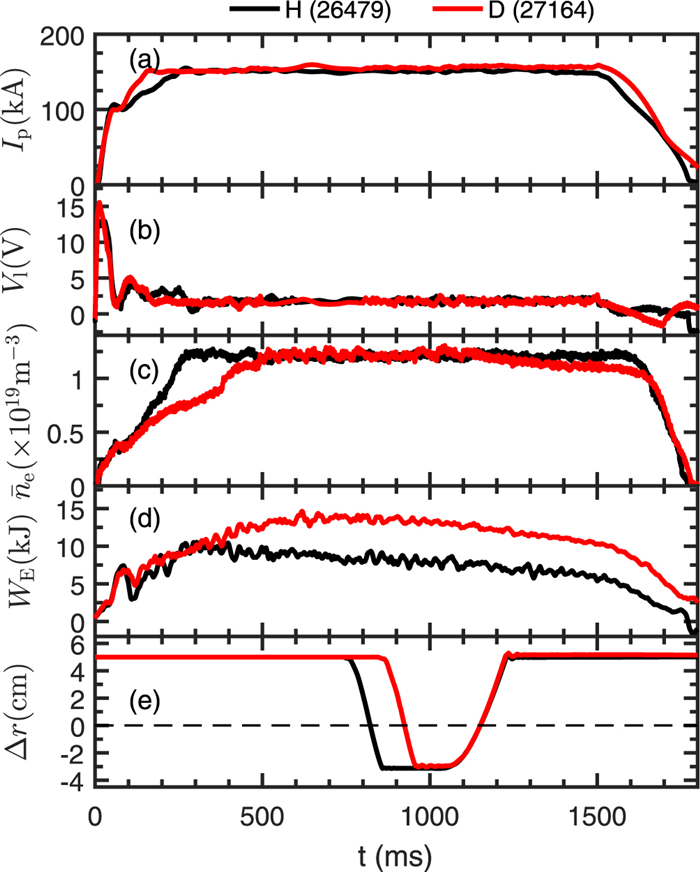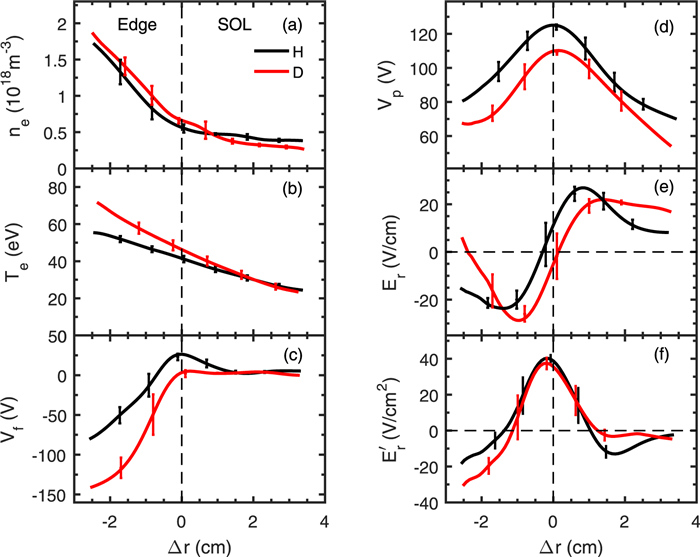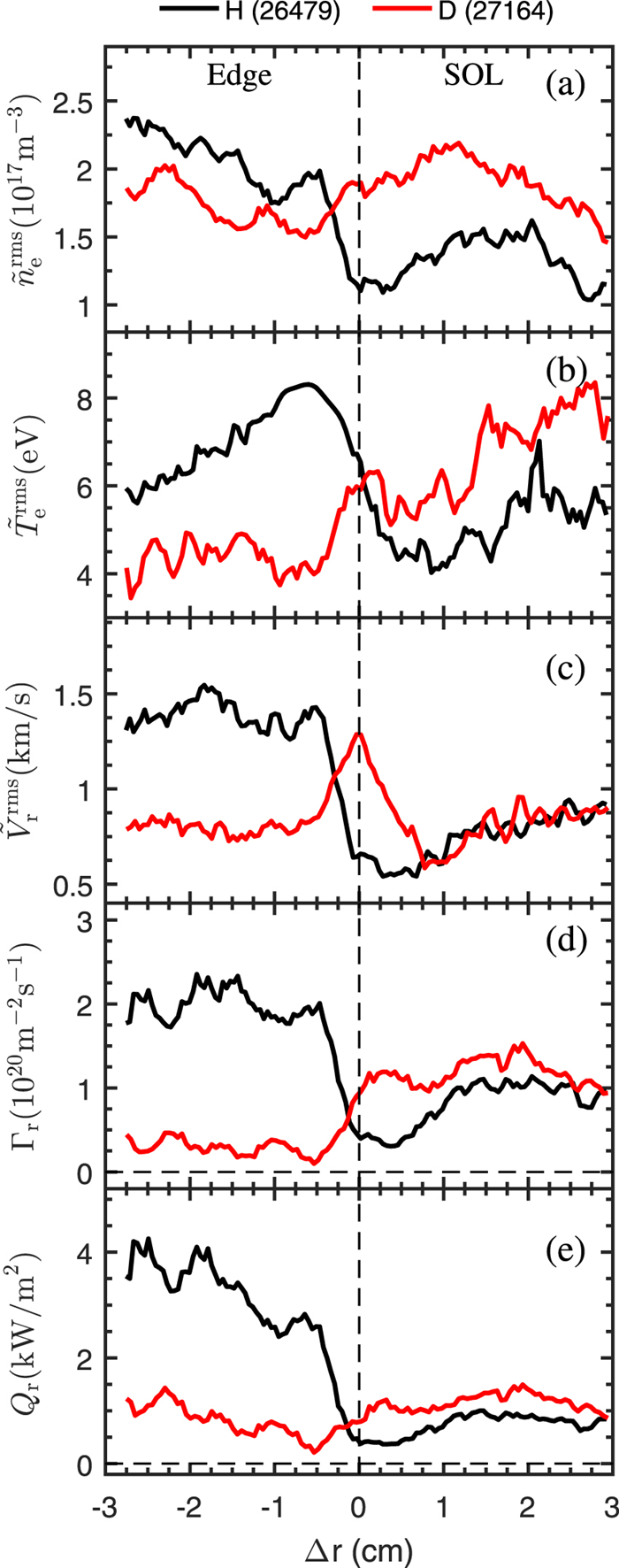
| Citation: | Hesen YANG, Hua LIANG, Shanguang GUO, Yanhao LUO, Mengxiao TANG, Chuanbiao ZHANG, Yun WU, Yinghong LI. Experimental study on surface arc plasma actuation-based hypersonic boundary layer transition flow control[J]. Plasma Science and Technology, 2022, 24(9): 095503. DOI: 10.1088/2058-6272/ac6d42 |
Effective control of hypersonic transition is essential. In order to avoid affecting the structural profile of the aircraft, as well as reducing power consumption and electromagnetic interference, a low-frequency surface arc plasma disturbance experiment to promote hypersonic transition was carried out in the Φ0.25 m double-throat Ludwieg tube wind tunnel at Huazhong University of Science and Technology. Contacting printed circuit board sensors and non-contact focused laser differential interferometry testing technology were used in combination. Experimental results showed that the low-frequency surface arc plasma actuation had obvious stimulation effects on the second-mode unstable wave and could promote boundary layer transition by changing the spectral characteristics of the second-mode unstable wave. At the same time, the plasma actuation could promote energy exchange between the second-mode unstable wave and other unstable waves. Finally, the corresponding control mechanism is discussed.
The influence of the isotope mass on plasma confinement properties has been a longstanding issue in magnetically confined plasmas. According to gyro-Bohm scaling [1, 2], the plasma transport diffusivity scales as
The first experimental observation in the TEXTOR tokamak has demonstrated that the amplitude of geodesic acoustic mode (GAM) zonal flows substantially increases during the transition from H to D dominated plasmas [9], which is qualitatively consistent with the GKV simulation [17]. However, up to date, there has been little evidence showing the increase of nonlinear interplay between ambient turbulence and zonal flows in heavier mass isotope plasmas.
In this paper, we present direct experimental evidence to expose the fact that in D majority plasmas, the nonlinear energy transfer plays a dominant role in exciting larger GAM zonal flows by extracting more energy from ambient turbulence, which results in lower turbulent transport and better confinement compared to H majority plasmas. The results provide additional proof for understanding the isotope effects in fusion plasmas.
The experiments were carried out in the Ohmically-heated H and D plasmas at the HL-2A tokamak with a limiter configuration. The major and minor radii are R = 165 cm and a = 40 cm, respectively, line-averaged plasma density
Typical discharge waveforms in H and D dominant plasmas are plotted in figure 1. It can be seen that with the same plasma current, loop voltage and line-averaged density, the plasma stored energy in D majority plasmas is higher than that in H ones, similar to those observed in other devices [4, 5, 7, 8, 10–12, 16]. Figure 1(e) shows time traces of the reciprocating Langmuir probes plunged in the stationary phase of the H and D discharges. The probe measurement in both discharges passed through approximately the same radial locations. It has been confirmed that the plasma horizontal position kept almost unchanged as the probes plunged into the plasma. Figure 2 depicts the edge equilibrium profiles averaged in several similar H (black) and D (red) majority discharges. Here, the ∆r = 0 denotes the LCFS location. As shown in figures 2(a) and (b), the local ne and Te in the edge region (inside the LCFS, ∆r < 0) are both enhanced in D plasmas, suggesting a higher edge pressure gradient, in agreement with higher stored energy achieved in the D plasma (see figure 1(d)). Inside the LCFS, both Vf and Vp are substantially lower in D plasmas than in H ones, leading to a slightly deeper Er well and larger Er shear (
In order to gain an insight into the isotope effects on turbulence levels and associated transport, we compared the RMS values of density, electron temperature and radial velocity fluctuations,
To understand the mechanisms responsible for the reduction of turbulent transport in the isotope deuterium plasmas, we analyzed the spectrum characteristics of edge turbulence and zonal flows in H and D plasmas. In HL-2A, a low frequency coherent mode with long-range toroidal correlations, namely GAM zonal flows, has been routinely observed in floating potential signals [32, 33]. Theories predict that the GAM zonal flow has poloidally symmetric (m/n = 0/0) potential and asymmetric (m/n = 1/0) density perturbations [34, 35]. In the present experiments, it is found that the maximum GAM amplitude presents at ∆r ≈ -3 cm inside the LCFS [36]. Plotted in figure 4 are the frequency spectra of floating potential (
According to theories [34, 35], the GAM frequency
To further compare the strength of the nonlinear coupling in turbulence between H and D plasmas, the squared auto-bicoherence [38], defined as b2(f1, f2) = |B(f1, f2)|2/(〈|X(f1)X(f2)|2〉〈|X(f1 ± f2)|2〉), where B(f1, f2) = 〈X(f1)X(f2)X*(f1 ± f2)〉 and X(f) is the Fourier transform of the fluctuation signal x(t), has been computed. Figures 6(a) and (b) show contour-plots of the squared auto-bicoherence estimated by floating potential fluctuation signals measured at ∆r ≈ - 3 cm in D and H dominant plasmas. It is clear that the bicoherence along the f2 = ±10 kHz and f2 = - f1 ± 10 kHz lines are much more prominent in D plasmas than that in H ones. This comparison illustrates stronger nonlinear coupling occurred between GAM zonal flows and turbulence in D plasmas. The summation of the squared bicoherence is calculated as
In summary, the isotope effects on plasma confinement, edge turbulence and turbulent transport as well as GAM zonal flows have been studied using a two-step Langmuir probe array in H and D majority plasmas in the HL-2A tokamak. Evidence shows that under similar discharge parameters the D plasma has better confinement and lower turbulent transport than the H plasma. Meanwhile, it is observed that the magnitude of GAM zonal flows, the tilting angle of the Reynolds stress tensor, and the turbulence correlation lengths are all larger in the edge region of the D plasma. The results provide direct experimental proof on the importance of the nonlinear energy transfer between turbulence and zonal flows for governing the isotope effects in fusion plasmas.
The work of this research is supported by National Science and Technology Major Project (No. J2019-II-0014-0035). Thanks to Associate Professor Wu Jie of Huazhong University of Science and Technology for the guidance of this experiment. Thanks to Sima Xuehao, Gui Yuteng and Huang Ranran for their help in the experiments.
| [1] |
Kimmel R 2003 Aspects of hypersonic boundary layer transition control 41st Aerospace Sciences Meeting and Exhibit 2003, 772
|
| [2] |
Qi H et al 2021 Adv. Aerodyn. 3 21 doi: 10.1186/s42774-021-00082-x
|
| [3] |
Middlebrooks J B et al 2021 Design of a hypersonic boundary layer transition control experiment utilizing a swept fin cone geometry in mach 6 flow AIAA Scitech 2021 Forum 2021 (AIAA) 1205 (https://doi.org/10.2514/6.2021-1205)
|
| [4] |
Yang H et al 2022 Adv. Aerodyn. 4 1 doi: 10.1186/s42774-022-00105-1
|
| [5] |
Chen J Q et al 2021 Appl. Therm. Eng. 194 116931 doi: 10.1016/j.applthermaleng.2021.116931
|
| [6] |
Fiévet R et al 2020 Numerical study of hypersonic boundarylayer transition delay through second-mode absorption AIAA SciTech 2020 Forum (Orlando) (AIAA)
|
| [7] |
Seleznev R K, Surzhikov S T and Shang J S 2019 Prog. Aerosp. Sci. 106 43 doi: 10.1016/j.paerosci.2019.02.001
|
| [8] |
Ding F et al 2018 Acta Astronaut. 152 639 doi: 10.1016/j.actaastro.2018.09.002
|
| [9] |
Reda D C, Wilder M C and Prabhu D K 2010 J. Spacecraft Rockets 47 828 doi: 10.2514/1.49112
|
| [10] |
Tang X J et al 2021 J. Phys. Conf. Ser. 2012 012027 doi: 10.1088/1742-6596/2012/1/012027
|
| [11] |
Tang X J et al 2021 J. Phys. Conf. Ser. 1748 052032 doi: 10.1088/1742-6596/1748/5/052032
|
| [12] |
Estruch-Samper D et al 2015 Shock Waves 25 521 doi: 10.1007/s00193-014-0514-7
|
| [13] |
Sun D et al 2020 Phys. Fluids 32 126111 doi: 10.1063/5.0030975
|
| [14] |
Demetriades A et al 2015 J. Spacecraft Rockets 13 508 doi: 10.2514/3.27924
|
| [15] |
Miró F M and Pinna F 2020 J. Fluid Mech. 890 R4 doi: 10.1017/jfm.2020.129
|
| [16] |
Lau K Y 2008 J. Spacecraft Rockets 45 176 doi: 10.2514/1.31134
|
| [17] |
Tang Q et al 2015 Phys. Fluids 27 064105 doi: 10.1063/1.4922389
|
| [18] |
Kornilov V I 2015 Prog. Aerosp. Sci. 76 1 doi: 10.1016/j.paerosci.2015.05.001
|
| [19] |
Miró F M et al 2019 AIAA J. 57 1567 doi: 10.2514/1.J057604
|
| [20] |
Tang H W et al 2020 Phys. Fluids 32 053605 doi: 10.1063/5.0006492
|
| [21] |
Yang H, Liang H and Zhao G 2021 P I Mech. Eng. I-J. Sys. 235 563
|
| [22] |
Yates H B et al 2020 AIAA J. 58 2093 doi: 10.2514/1.J058981
|
| [23] |
Stetson K 1983 Nosetip bluntness effects on cone frustum boundary layer transition in hypersonic flow 16th Fluid and Plasmadynamics Conf. (Danvers) (AIAA)
|
| [24] |
Kosinov A D, Maslov A A and Semionov N V 1996 Modified method of experimental study of supersonic boundary layer receptivity ed A M Kharitonov Proc. of the Int. Conf. on the Methods of Aerophysical Research (Springer)
|
| [25] |
Maslov A A et al 2001 J. Fluid Mech. 426 73 doi: 10.1017/S0022112000002147
|
| [26] |
Casper K M, Beresh S J and Schneider S P 2014 J. Fluid Mech. 756 1058 doi: 10.1017/jfm.2014.475
|
| [27] |
Yates H et al 2018 Plasma-actuated flow control of hypersonic crossflow-induced boundary-layer transition in a Mach-6 quiet tunnel 2018 AIAA Aerospace Sciences Meeting (Kissimmee, FL) (AIAA)
|
| [28] |
Zhang Y C, Li C and Lee C B 2020 Phys. Fluids 32 071702 doi: 10.1063/5.0011299
|
| [29] |
Li C, Zhang Y C and Lee C B 2020 Phys. Fluids 32 051701 doi: 10.1063/5.0008457
|
| [30] |
Roth J R, Sherman D M and Wilkinson S P 2000 AIAA J. 38 1166 doi: 10.2514/2.1110
|
| [31] |
Xiong Y et al 2020 AIAA J. 58 5254 doi: 10.2514/1.J059263
|
| [32] |
Tao Y et al 2021 Chinese J. Aeronaut. 34 17 doi: 10.1016/j.cja.2020.09.033
|
| [33] |
Yang H S et al 2021 Plasma Sci. Technol. 23 115502 doi: 10.1088/2058-6272/ac1395
|
| [34] |
Tang B L et al 2020 Acta Phys. Sin. 69 155201 doi: 10.7498/aps.69.20200216
|
| [35] |
Stetson K and Kimmel R 1992 On hypersonic boundary-layer stability 30th Aerospace Sciences Meeting and Exhibit (Reno) (AIAA)
|
| [36] |
Mack L M 1984 Boundary-layer linear stability theory AGARD Report 709
|
| [37] |
Yang H et al 2020 Acta Aeronaut. Astronaut. Sin. 41 623319(in Chinese)
|
| [38] |
Tang M X et al 2022 J. Fluid Mech. 931 A16 doi: 10.1017/jfm.2021.973
|
| [39] |
Sun Q et al 2014 Phys. Lett. A 378 2672 doi: 10.1016/j.physleta.2014.07.016
|
| [40] |
Adam P H and Hornung H G 1997 J. Spacecraft Rockets 34 614 doi: 10.2514/2.3278
|
| [41] |
Fedorov A et al 2015 AIAA J. 53 2512 doi: 10.2514/1.J053666
|
| [42] |
Xie L K et al 2019 Sens. Actuators A Phys. 297 111550 doi: 10.1016/j.sna.2019.111550
|
| [43] |
Soudakov V G, Fedorov A V and Egorov I V 2015 Prog. Flight Phys. 7 569
|
| [44] |
Zhang X et al 2020 Plasma Sources Sci. Technol. 29 015017 doi: 10.1088/1361-6595/ab5733
|
| [45] |
Zhang X, Zhao Y G and Yang C 2022 Chinese J. Aeronaut. accepted (https://doi.org/10.1016/j.cja.2022.01.026)
|
| [46] |
Fedorov A 2011 Annu. Rev. Fluid Mech. 43 79 doi: 10.1146/annurev-fluid-122109-160750
|
| [47] |
Tirumala R et al 2014 J. Phys. D: Appl. Phys. 47 255203 doi: 10.1088/0022-3727/47/25/255203
|
| [1] | Yaguang MEI (梅亚光), Shusen CHENG (程树森), Zhongqi HAO (郝中骐), Lianbo GUO (郭连波), Xiangyou LI (李祥友), Xiaoyan ZENG (曾晓雁), Junliang GE (葛军亮). Quantitative analysis of steel and iron by laser-induced breakdown spectroscopy using GA-KELM[J]. Plasma Science and Technology, 2019, 21(3): 34020-034020. DOI: 10.1088/2058-6272/aaf6f3 |
| [2] | Jiamin LIU (刘佳敏), Ding WU (吴鼎), Cailong FU (付彩龙), Ran HAI (海然), Xiao YU (于潇), Liying SUN (孙立影), Hongbin DING (丁洪斌). Improvement of quantitative analysis of molybdenum element using PLS-based approaches for laser-induced breakdown spectroscopy in various pressure environments[J]. Plasma Science and Technology, 2019, 21(3): 34017-034017. DOI: 10.1088/2058-6272/aaf821 |
| [3] | Congyuan PAN (潘从元), Jiao HE (何娇), Guangqian WANG (王广谦), Xuewei DU (杜学维), Yongbin LIU (刘永斌), Yahui SU (苏亚辉). An efficient procedure in quantitative analysis using laser-induced breakdown spectroscopy[J]. Plasma Science and Technology, 2019, 21(3): 34012-034012. DOI: 10.1088/2058-6272/aaf50f |
| [4] | Qingdong ZENG (曾庆栋), Fan DENG (邓凡), Zhiheng ZHU (朱志恒), Yun TANG (唐云), Boyun WANG (王波云), Yongjun XIAO (肖永军), Liangbin XIONG (熊良斌), Huaqing YU (余华清), Lianbo GUO (郭连波), Xiangyou LI (李祥友). Portable fiber-optic laser-induced breakdown spectroscopy system for the quantitative analysis of minor elements in steel[J]. Plasma Science and Technology, 2019, 21(3): 34006-034006. DOI: 10.1088/2058-6272/aadede |
| [5] | Xiaoyong HE (何小勇), Runhua LI (李润华), Fujuan WANG (王福娟). Elemental analysis of copper alloy by high repetition rate LA-SIBS using compact fiber spectrometer[J]. Plasma Science and Technology, 2019, 21(3): 34005-034005. DOI: 10.1088/2058-6272/aae1f1 |
| [6] | Dan LUO (罗丹), Ying LIU (刘英), Xiangyu LI (李香宇), Zhenyang ZHAO (赵珍阳), Shigong WANG (王世功), Yong ZHANG (张勇). Quantitative analysis of C, Si, Mn, Ni, Cr and Cu in low-alloy steel under ambient conditions via laser-induced breakdown spectroscopy[J]. Plasma Science and Technology, 2018, 20(7): 75504-075504. DOI: 10.1088/2058-6272/aabc5d |
| [7] | Yuqing XIONG (熊玉卿), Hengjiao GAO (高恒蛟), Ni REN (任妮), Zhongwei LIU(刘忠伟). Atomic layer deposition of copper thin film and feasibility of deposition on inner walls of waveguides[J]. Plasma Science and Technology, 2018, 20(3): 35507-035507. DOI: 10.1088/2058-6272/aa9cdf |
| [8] | Shuxia ZHAO (赵书霞), Lei ZHANG (张雷), Jiajia HOU (侯佳佳), Yang ZHAO (赵洋), Wangbao YIN (尹王保), Weiguang MA (马维光), Lei DONG (董磊), Liantuan XIAO (肖连团), Suotang JIA (贾锁堂). Accurate quantitative CF-LIBS analysis of both major and minor elements in alloys via iterative correction of plasma temperature and spectral intensity[J]. Plasma Science and Technology, 2018, 20(3): 35502-035502. DOI: 10.1088/2058-6272/aa97ce |
| [9] | ZHU Dehua (朱德华), CAO Yu (曹宇), ZHONG Rong (钟蓉), CHEN Xiaojing (陈孝敬). Quantitative Analysis of Composition Change in AZ31 Magnesium Alloy Using CF-LIBS After Laser Material Processing[J]. Plasma Science and Technology, 2015, 17(11): 909-913. DOI: 10.1088/1009-0630/17/11/03 |
| [10] | MAO Yangwu(毛样武), GUO Beibei(郭贝贝), NIE Dunwei(聂敦伟), Domenico MOMBELLO. Tarnish Testing of Copper-Based Alloys Coated with SiO 2 -Like Films by PECVD[J]. Plasma Science and Technology, 2014, 16(5): 486-490. DOI: 10.1088/1009-0630/16/5/08 |
| 1. | Qin, C., Huang, J., Li, M.-S. The isotope effect on ion temperature gradient mode in CFQS | [CFQS 中离子温度梯度模的同位素效应研究]. Hejubian Yu Dengliziti Wuli/Nuclear Fusion and Plasma Physics, 2024, 44(3): 359-366. DOI:10.16568/j.0254-6086.202403017 | |
| 2. | Zhou, H., Xu, Y., Kobayashi, M. et al. Isotope effects on transport characteristics of edge and core plasmas heated by neutral beam injection (NBI) in an inward shifted configuration at the Large Helical Device. Nuclear Fusion, 2024, 64(3): 036023. DOI:10.1088/1741-4326/ad22f6 |

